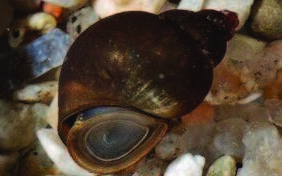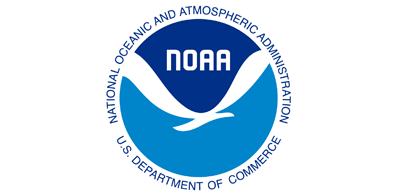
Faucet Snail
(Bithynia tentaculate)
Species at a Glance
The Faucet Snail is a small freshwater snail that grazes and filters algae from lakes. It is native to Europe and was most likely introduced to the Great Lakes through contaminated solid ballast of large timber transport ships, or from vegetation used in packing crates. The Faucet Snail gets its name from its affinity to infest municipal water supplies, where it has been found sliding out of water faucets in its native range.
Species Description
The shell of the Faucet Snail is 12–15 mm (0.4 – 0.6 inches), pale brown in color, oval, and has 4-5 whorls. The opening of the shell is located on the right-hand side when the shell is pointed up. The operculum, which functions as a trapdoor to seal the opening of the shell, has concentric rings that resemble a bullseye. The faucet snail has long, pointed tentacles and a simple foot with a lobe acting as a channel for water.
Native and Introduced Ranges
Native to Europe, the Faucet Snail was first introduced to the Great Lakes region of the United States in the 1870s. Populations found outside of the Great Lakes are likely the result of natural spread from this region, rather than separate introductions. In Pennsylvania, the Faucet Snail can be found in a few northeastern and north-central counties.
Biology & Spread
The earliest observation of the Faucet Snail in the Great Lakes was from Lake Michigan in 1871. It was most likely introduced to the Great Lakes basin by hitchhiking in packing material, through solid ballast in timber ships, or by deliberate release. Having the ability to attach to boats, trailers, docks, and other equipment, the Faucet Snail can be spread through the transportation of water-related equipment. It can also close its operculum and survive out of water for several days.
Habitat
Commonly found in freshwater ponds, shallow lakes, and canals, the Faucet Snail attaches itself to objects in the water. In fall and winter months it is usually found on rocks and bottom substrates but moves to aquatic plants in warmer months. Due to its ability to filter feed, the Faucet Snail population can survive in water bodies that are disturbed and high in nutrients.
Impacts
Threat to Biodiversity
The Faucet Snail outcompetes native snail species for food and habitat. For example, in New York, it has been found to replace snails of the family Pleuroceridae, especially in polluted waters. This has been attributed to its ability to switch between grazing and filter-feeding, giving it a competitive advantage.
Economic Costs
In the early 1900s, the Faucet Snail began infesting municipal water supplies, including household faucets, giving rise to the snail’s name. The Faucet Snail clogs water intake pipes, screens, and other submerged equipment. In Erie, Pennsylvania, studies cite that the water supplies became so infested that “wagon loads” of Faucet Snails were removed from municipal water pumping stations.
Wildlife Health
The Faucet Snail is a key host for three species of trematode parasites that can be deadly to waterbirds that consume them, such as ducks, coots, and swans. This can result in ecological health declines in wetlands and waterfowl populations.
Prevention & Control
Once established, controlling the Faucet Snail can be very difficult. Preventing its introduction and spread is the best way to protect natural habitats from harm.
- Know how to identify and report the Faucet Snail.
- Always check for and remove plants, mud, and debris from boats, trailers, clothing, and equipment before entering a water body and before leaving a water body.
- Drain all water from bait buckets, bilges, and live wells before transporting to new areas.
- Clean all gear and equipment with hot water (140°F or 40°C) or salt water, OR let boats and equipment dry thoroughly for at least five days before entering a new water body.
- When choosing plants for a pond or water garden, purchase from a licensed nursery and choose regionally native or non-invasive plants. Check with your state natural resource agency to confirm which plants to avoid for your region.
Scan Now! To access additional AIS fact sheets, resources, and reporting methods. Or visit us online at https://seagrant.psu.edu/aquatic-invasive-species/
References:
- Kipp, R.M., A.J. Benson, J. Larson, and A. Fusaro, 2021, Bithynia tentaculata (Linnaeus, 1758): U.S. Geological Survey, Nonindigenous Aquatic Species Database, Gainesville, FL, Mud Bithynia — Bithynia tentaculata. Montana Field Guide. Montana Natural Heritage Program.
- Simithsonian Environmental Research Center, 2021, Bithynia tentaculate – Mollusks-Gastropods.
- Department of Natural Resources, 2021, Faucet Snail (Bithynia tentaculata), U.S. Fish and Wildlife Service, 2015, Faucet Snail (Bithynia tentaculata), Ecological Risk Screening Summary.
- University of Wisconsin Sea Grant, Faucet Snail.



